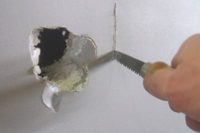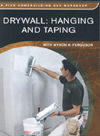As a long, hot summer eases into fall, the Chinese drywall situation that has impacted North America since the beginning of the year deserves a retrospective review as it relates to domestic gypsum board production.
The key issue in the Chinese drywall situation? Some wallboard imported from China reportedly off-gassed an unpleasant “rotten egg” odor, and the substance causing the odor apparently corroded electrical wiring, refrigerator evaporator coils, appliance circuitry, and other metals.
The exact cause or causes for these problems is under investigation by several governmental agencies, including the National Institute of Sciences and the Consumer Product Safety Commission. Since early April, the Gypsum Association has cooperated fully with the agencies, in particular the CPSC, in the investigations. As this article was being written (early September), CPSC representatives were attempting to gain access to manufacturing facilities and quarries in China.
The wallboard in question was apparently imported from China between 2005 and 2007, when the U.S. housing boom was at its peak and North American producers could not keep up with domestic wallboard demand. According to data obtained from the U.S. Census Bureau, about 320 million square feet of wallboard was imported from China, less than one-half of one percent of the wallboard sold in the United States. Most of the imported board was used in Gulf and Atlantic coast regions in Florida, Texas, Virginia, Louisiana and Alabama. According to census data, only a smattering amount (approximately 15, 000 square feet) of Chinese board has been directly imported into the U.S. since March 2009.
HEAVY DEMAND CALLED FOR IMPORTED PRODUCT
During most years, U.S. demand is satisfied by North American production as board flows freely into the U.S. from Canada and Mexico; however, the mid-decade housing market was so superheated that it created a demand for gypsum board from any source, and the Chinese material filled the gap. A similar, but not quite as large, demand disparity occurred in the period 1999 through 2001. It was satisfied by board imported from Europe and South America-primarily Poland, Norway, Germany and Chile. In the most recent instance, European housing markets, like their North American counterparts, were running flat-out, and most all European board production was being absorbed by continental demand; thus, the opportunity to import wallboard from half-way around the world presented itself.
By code, all gypsum board used in the U.S. must meet the internationally recognized consensus standard, ASTM C 1396, Standard Specification for Gypsum Board. This standard requires each gypsum panel or package to have specific information marked on it: the thickness, the name of the producer or supplier, the brand name, and the ASTM specification for the product. Whether all the board imported from China was properly marked has been a point of some conjecture and dispute; however, all wallboard manufactured in the U.S. and Canada is marked in accordance with the standard. The marking typically is on the bundling tape that binds two sheets of board into a single shipping unit.
All gypsum wallboard made in the U.S. and Canada is manufactured by members of the Gypsum Association, either from natural or byproduct (synthetic) gypsum. While natural gypsum is present on every continent throughout the world, including Asia, Gypsum Association members only use ore that is mined or quarried in North America and do not import ore from other hemispheres.
Most of the byproduct gypsum used in North America to manufacture wallboard is produced when coal-fired power plants clean their stacks. Stack emissions are fed through a limestone slurry and oxygenated in a process that yields flue gas desulfurization gypsum. Wallboard-grade byproduct gypsum and natural gypsum are chemically identical.
U.S. board producers use about two-thirds of all the FGD gypsum that is produced domestically to manufacture gypsum board and currently make about one-third of all the board sold in the U.S. from byproduct gypsum. Manufacturers have used byproduct gypsum to make board for over two decades and have diverted millions of tons of waste material away from landfills during that time.
WHO’S TO BLAME?
Arguments about what has caused the situation are plentiful. One early assertion was that the Chinese board contained fly ash instead of FGD gypsum. Fly ash is a solid residue created by the burning of coal. It has a different chemical composition than gypsum and is not used by North American manufacturers as a substitute for gypsum in manufacturing gypsum wallboard. Because both fly ash and FGD are created when coal is burned, some of the “fly ash in the wallboard” claims may be attributed to a misunderstanding of the coal byproduct process. CPSC continues to explore the claim as it relates to the imported board as a part of its overall investigation.
The possible presence of phosphogypsum-a type of gypsum formed when phosphate is processed into fertilizer-in the Chinese board was also seized on by some parties as a possible culprit and a source of concern. Gypsum Association members do not use phosphogypsum to manufacture any gypsum-based products due to the possible presence of naturally occurring radio nuclides in the phosphate ore.
In an August report, CPSC largely ruled out phosphogypsum as a contributing element to the problem and a source of concern when it indicated that it had tested numerous samples of drywall, both domestic and Chinese sourced, and had “testing (that) showed levels that do not pose a radiation safety risk to families.”
In addition to the work being undertaken by CPSC et al, legislation has been introduced in Congress to address the situation. The legislation proposes to obtain funding for the CPSC study-money that has been obtained, in part, by a special appropriation-and to establish parameters to prevent a similar situation from occurring during future demand spikes. Association representatives are working with the bill’s sponsors to ensure that the outcome doesn’t inappropriately hamper the ability of the domestic manufacturers to supply gypsum board.
Domestically produced gypsum wallboard has been used successfully in the construction of homes and buildings in North America for more than 100 years with an excellent performance record. Contractors should have no reservations about installing gypsum wallboard manufactured by members of the Gypsum Association. W&C
Get our new eMagazine delivered to your inbox every month.
Stay in the know on the latest in the wall and ceiling industry.
SUBSCRIBE NOWCopyright ©2024. All Rights Reserved BNP Media.
Design, CMS, Hosting & Web Development :: ePublishing





Report Abusive Comment